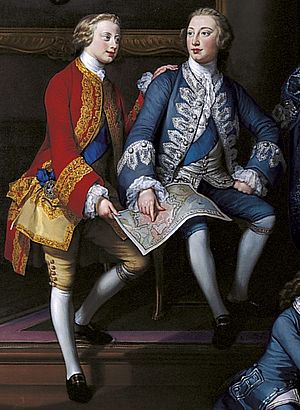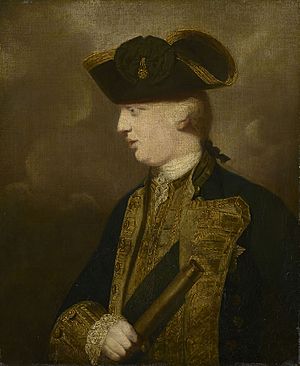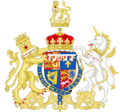Prince Edward, Duke of York and Albany facts for kids
Quick facts for kids Prince Edward |
|||||
|---|---|---|---|---|---|
| Duke of York and Albany | |||||

Portrait by Pompeo Batoni, c. 1764
|
|||||
| Born | 25 March 1739 Norfolk House, St James's Square, Westminster |
||||
| Died | 17 September 1767 (aged 28) Prince's Palace, Monaco-Ville |
||||
| Burial | 1 November 1767 Westminster Abbey, London |
||||
|
|||||
| House | Hanover | ||||
| Father | Frederick, Prince of Wales | ||||
| Mother | Princess Augusta of Saxe-Gotha | ||||
| Military career | |||||
| Allegiance | |||||
| Service/ |
|||||
| Years of service | 1759–1767 | ||||
| Rank | Admiral of the Blue and Vice-admiral of the blue | ||||
| Battles/wars | Seven Years' War | ||||

Prince Edward, Duke of York and Albany (born Edward Augustus; 25 March 1739 – 17 September 1767) was a member of the British Royal Family. He was the younger brother of King George III, who ruled the United Kingdom. Edward was the second son of Frederick, Prince of Wales, and Princess Augusta of Saxe-Gotha.
Contents
Early Life and Education
Edward Augustus was christened at Norfolk House by the Bishop of Oxford, Thomas Secker. His godparents included important figures like the King in Prussia and the Duke of Brunswick-Wolfenbüttel.
As a young boy, Edward and his brother spent many hours studying. They learned subjects like arithmetic, Latin, geometry, writing, and religion. They also studied French, German, and Greek. Even dancing was part of their education to make them well-rounded.
Prince Edward was very interested in ships and the navy. He asked for permission to join the Royal Navy. He took part in naval attacks against the French coast during the Seven Years' War.
One of these attacks was the failed Raid on St Malo in 1758. This raid ended with the Battle of Saint-Cast. Edward was promoted to captain of HMS Phoenix in 1759. He continued to rise through the ranks. He became a Rear-Admiral of the Blue in 1761 and a Vice-admiral of the Blue in 1762. Just a year before he died, he reached the rank of Admiral of the Blue in 1766.
Later Life and Royal Duties

On 1 April 1760, Edward's grandfather, King George II, gave him the titles of Duke of York and Albany and Earl of Ulster.
When Edward's brother became King George III on 25 October 1760, he made Edward a privy counsellor. This meant Edward was a trusted advisor to the King. From the time his brother became king until the birth of the future King George IV in 1762, Edward was the next in line to the British throne.
In the late summer of 1767, the Duke became very ill while traveling to Genoa. He had to stop in the harbor of Monaco. Despite receiving good care, he passed away in the Palace of Honoré III, Prince of Monaco, on 17 September. The room where he died is now known as the York Room.
After his death, his body was brought back to London on the ship HMS Montreal. He was buried in Westminster Abbey.
Legacy and Namesakes
Prince Edward's name lives on in various places and in literature.
Literature and Art
- In 1762, writer James Boswell published a poem called "The Cub at Newmarket". He dedicated this poem to Prince Edward. Boswell had met the prince at horse races in 1760.
- Prince Edward is an important character in Norah Lofts' historical novel The Lost Queen (1969). This book tells the story of his youngest sister, Caroline Matilda, who became Queen of Denmark and Norway. The book suggests Edward had a special bond with her.
Places and People Named After Prince Edward
Many places and even a person were named in honor of Prince Edward:
- Prince Edward County, Virginia in the United States.
- Cape York, which is the northernmost point of Australia. It is located on the Cape York Peninsula in Far North Queensland.
- The Duke of York Islands in Papua New Guinea. These islands are found between New Britain and New Ireland islands.
- Duke of York Island is the largest island in the Duke of York Islands group.
- Prince Edward Augustus, the fourth son of King George III, was born the day after the Duke of York was buried.
- Fort Edward, a town in New York state. This town was once the site of a large British fort during the Seven Years' War.
Titles and Honors
Prince Edward held several important titles and received special honors during his life.
Titles and Styles
- From 25 March 1739 to 1 April 1760: His Royal Highness Prince Edward
- From 1 April 1760 to 17 September 1767: His Royal Highness The Duke of York and Albany
Honors
- 1752: He became a Royal Knight of the Garter (KG). This is a very old and important award in Britain.
- 1760: He was made a Privy Counsellor (PC).
- 1760: He became a Royal Fellow of the Royal Society (FRS).
Images for kids
-
The Duke of York and Albany in his robes for the Order of the Garter, around 1764–1765
See also
 In Spanish: Eduardo de York y Albany para niños
In Spanish: Eduardo de York y Albany para niños



